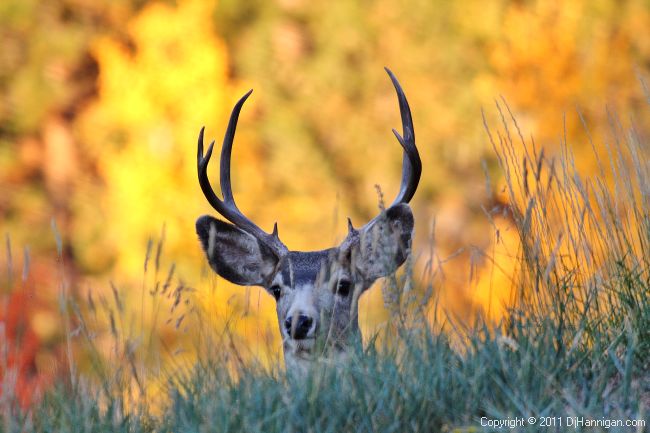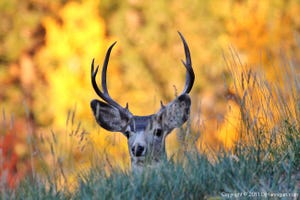Why Consider Wildlife In Your Ranch Management Plans?
September 15, 2014

It is likely that, since the first cow set her first hoof on North American soil, both she and the person who turned her out had to deal with wildlife interactions. And for most of the time that cows and critters have shared the habitat, those interactions were viewed with disfavor.
In the case of predators like wolves, mountain lions and coyotes, those interactions can still have direct and very negative consequences, at least from the perspective of both the cow and the cattle producer. But many cattle producers have found that sound range management practices benefit cattle and wildlife alike.
And more and more, ranchers are realizing that there’s both an economic and an aesthetic benefit to incorporating wildlife management into their ranch management plans. In Texas, for example, ranchers have long recognized the benefits of hunting and other recreational leases, and wildlife considerations have long been a part of the management mix. That’s happening in many other states as well, and that’s a positive trend.
What’s more, it’s something we need to celebrate. Here’s a roundup of three articles that do just that as they highlight how ranchers can manage for both cattle and wildlife:
Fencing For Wildlife And Cattle
Long-time Wyoming rancher John Nunn’s land is near a route where pronghorn migrate. His ranch is surrounded by woven fences, and although the pronghorn can sometimes find a way through, he wanted to ease access for them.
“We found they would go a certain path, and we didn’t want to jeopardize that,” Nunn said.
Nunn is one of several producers in Wyoming who recognize that the existing woven wire and 5- to 6-wire barbed fences prevent pronghorn, deer and elk from freely moving and migrating through their lands. That’s when he looked into wildlife-friendly fencing as a replacement for the fencing that was put on his land before he owned it.
Nunn and others applied for assistance from USDA’s Natural Resources Conservation Service (NRCS) to help them replace their existing wire fence into a wildlife friendly fence with funding from the Environmental Quality Incentives Program.
These new fences allow pronghorn antelope and other big game to pass through the fence without the risk of getting tangled in the wires. The fence wire spacing allows pronghorn to crawl under the fence, while the lighter-on-their-feet deer and elk can easily jump over the fence – all with minimum risk of injury.
Meanwhile, these fences still keep cattle inside. Click here to read more.
Getting Paid To Manage Wildlife Habitat

Photo Credit: Colorado Parks and Wildlife
The California drought is putting the livelihoods of farmers and ranchers at serious risk. Without a reliable water supply, many fields are going fallow. This not only threatens the state’s world-leading agricultural economy, it significantly impacts wildlife species that depend on agricultural lands for survival.
A pioneering program under development in California’s Central Valley, however, may offer farmers and wildlife some relief. It’s called the Central Valley Habitat Exchange, and while it wasn’t conceived for the expressed purpose of helping growers in times of drought, it can reward producers who provide habitat by growing less water-intensive crops. Here’s how.
Under a habitat exchange, businesses and agencies that need to meet conservation goals can contract with farmers and ranchers to restore and maintain habitat on their lands. Exchanges provide a marketplace (not unlike a produce exchange) that allows for fast, transparent and efficient transactions between landowners who can improve or maintain habitat and buyers who need to meet corporate, conservation or regulatory commitments, such as developers required by law to mitigate the impacts their operations cause to sensitive environments.
Click here for more on the habitat exchange.
Idaho Ranch Uses “All Land Management”
From a hilltop in the upper Pahsimeroi Valley, Rosana Rieth points to a large pancake-like flat. That’s where about 80-100 sage grouse come to mate each spring in the shadow of the highest mountain peaks in Idaho’s Lost River Mountains.
It’s a perfect spot for a sage grouse lek – the land is flat, surrounded by sagebrush, remote and next to the Pahsimeroi River.
After the chicks hatch, the hens take their broods from public land to a wet meadow belonging to the Big Creek Ranch. When owner Tom Page contacted Rieth, a Natural Resources Conservation Service (NRCS) rangeland management specialist of USDA’s Natural Resources Conservation Service, she was delighted to hear of his interest in improving the meadow on his land to make it a better fit for wildlife.
She soon helped him apply for project funding from the Sage Grouse Initiative (SGI), a partnership program dedicated to achieve wildlife conservation through sustainable ranching.
“I love working with SGI — the flexibility is the really great thing,” Page says. “The project can be about fencing. It can be about a revegetation project, or potentially it can be about funding for a conservation easement. I also like that the SGI program works effectively with other federal and state agencies.”
Click here for more information on Page’s efforts to conserve sage grouse.
Clearly there’s a downside to the increased interest in the wildlife and recreational value of ranchland. Real estate values and pasture lease rates have both seen significant price inflation. That’s bad if you’re competing with recreational dollars to buy or lease a ranch; it’s good if you own the ranch and can capitalize.
These are only three examples of efforts that are happening throughout cattle country where ranchers, non-profit organizations and government agencies come together to find solutions that work for everyone. It’s a trend we must continue. And a trend we must talk about every chance we get.
You might also like:
Are Your Sorting Skills Up To Snuff?
BEEF Exclusive: Herd Expansion? BEEF Readers Say Its Go Time
15 ATVs and UTVs That Are New For 2014
10 Ways To Have A Stress-Free Weaning Day
Effective Heifer Development Means Thinking Early & Long Term
You May Also Like


.png?width=300&auto=webp&quality=80&disable=upscale)
